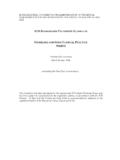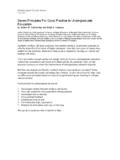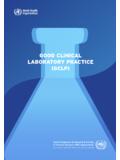Transcription of Twenty principles for good spreadsheet practice
1 Twenty principles for good spreadsheet practice Second edition WITH CONFIDENCEDPage footer ICAEW 2015 All rights reserved. If you want to reproduce or redistribute any of the material in this publication, you should first get ICAEW s permission in writing. ICAEW will not be liable for any reliance you place on the information in this publication. You should seek independent 978-1-78363-150-6 CONTENTSPREFACE 01 WHY Twenty principles ? 02 THE Twenty principles EXPLAINED AND ILLUSTRATED 03 The spreadsheet s business environment 04 Designing and building your spreadsheet 06 spreadsheet risks and controls 13 Foreword by MazarsSupported byOne year ago, ICAEW first published its Twenty principles for good spreadsheet practice .
2 The principles were launched as a response to the increased recognition of the risks and waste caused by poor spreadsheet practice . We believe that having a set of principles developed by an independent and respected body represents an important milestone in addressing these issues. We have been actively involved in the development of the principles and are strong advocates of their wider adoption. We are therefore delighted that ICAEW is progressing this initiative by producing this updated edition and taking the time to consider how the principles are being used in Mazars team works on building and reviewing spreadsheets for a range of uses across industry.
3 Over the past year we have begun to use the principles in a number of different ways to help drive change, for example: as a benchmark to evaluate and improve models for our clients; we find they provide an excellent basis on which to recommend change in governance and implementation of modelling best practice ; and to reinforce with clients the importance of adopting spreadsheet standards, such as the FAST Modelling Standard which we believe to be vital in order to improve productivity and reduce risk when using spreadsheets across their have also taken an active role in helping promote the principles more widely across industry.
4 As an example, when it comes to public procurement, we can see that a requirement for bidder financial models to be compliant with the principles would be much more useful than the current obligations, which look to undefined notions of best practice . We have written about this in more detail in our blog which is dedicated to financial model review you haven t already reviewed the principles , we urge you and your teams to do so and see whether you think that their adoption could help reduce the amount of time wasted and the potential for costly and embarrassing error in your business.
5 After one year, the principles have begun to demonstrate their worth in practice and we believe that their wider promotion and adoption offers a real opportunity to make a step-change in industry practice . We wholeheartedly recommend them to you. Jerome BricePartner and Head of Model AuditALike it or not, spreadsheets are in use everywhere. They have become the lingua franca of business; no matter what your system or requirement, a spreadsheet can connect people like no other business , the use of spreadsheets is not without risk, and approximately 90% of spreadsheets contain mistakes.
6 Material errors such as incorrect models, sending out sheets with hidden columns or careless use of formulae, have been well publicised alongside the embarrassment and financial loss that arise as a addition, there is a serious problem of waste arising from spreadsheets that are created inefficiently or carelessly. 65% of members of the Excel Community are self-taught, and with no formal methodology there is a risk that sub-optimal models and processes become the norm. This is why ICAEW s Excel Community Advisory Committee came together to develop Twenty principles for good spreadsheet practice that look to reduce spreadsheet risk and inefficiency in all organisations regardless of size or sector.
7 I would like to thank all the members of the committee for developing these principles , and would encourage readers to act on the recommendations in this report. Michael Izza Chief Executive Officer, ICAEWP reface01 Twenty principles for good spreadsheet practiceMany spreadsheets evolve over time without well-structured design or integrity checks, and are poorly documented. Making a relatively simple change can often take a long time, have unexpected consequences and/or result in errors from incorrect calculations or input assumptions, as famously illustrated by debacles such as the bidding process for the West Coast mainline Why Twenty principles ?
8 The purpose of these principles is to help reduce the amount of time wasted, and the number of errors caused, by businesses (including accountancy practices ) as a consequence of the way they and their employees use are several points to emphasise. First, no set of principles or standards can guarantee freedom from error. The design, maintenance and operation of spreadsheets are still carried out by humans. Secondly, this document is not only about good spreadsheet design . The business environment in which spreadsheets are created, maintained and used is at least as important.
9 So the first four principles are ones we believe should be adopted by an organisation before anyone starts to work on any individual spreadsheet -using project. They are intended to create a framework, and to instil attitudes, which encourage best- practice to flourish. These principles are addressed not only to those directly involved in the design and use of spreadsheets but also to those with managerial responsibility, including responsibility for management of risk. They may also be of interest and relevance to those with responsibility for , these are principles , not standards.
10 By way of example, Principle 2 requires clarity and consistency in the use of formatting. This could mean using a particular cell colour to denote cells allowing user input. There might be any number of different corporate standards, or publicly available standards, that adhere to this principle. One standard might specify pink as the colour for input cells; another might specify green. Either would satisfy the , this set of principles is not meant to be comprehensive, nor is it meant to be very detailed. Deliberately it focuses mainly on traditional formula-driven spreadsheet construction, which still accounts for the vast majority of spreadsheet use, rather than on pivot tables, structured references etc.






